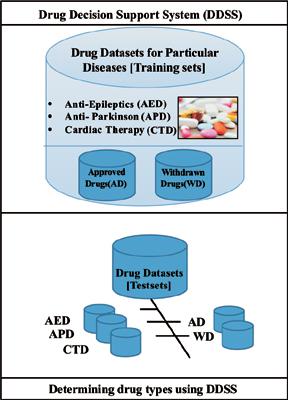Current Computer-Aided Drug Design ( IF 1.5 ) Pub Date : 2020-07-31 , DOI: 10.2174/1573409915666190716143601 Aytun Onay 1 , Melih Onay 2

|
Background: Virtual screening of candidate drug molecules using machine learning techniques plays a key role in pharmaceutical industry to design and discovery of new drugs. Computational classification methods can determine drug types according to the disease groups and distinguish approved drugs from withdrawn ones.
Introduction: Classification models developed in this study can be used as a simple filter in drug modelling to eliminate potentially inappropriate molecules in the early stages. In this work, we developed a Drug Decision Support System (DDSS) to classify each drug candidate molecule as potentially drug or non-drug and to predict its disease group.
Methods: Molecular descriptors were identified for the determination of a number of rules in drug molecules. They were derived using ADRIANA.Code program and Lipinski's rule of five. We used Artificial Neural Network (ANN) to classify drug molecules correctly according to the types of diseases. Closed frequent molecular structures in the form of subgraph fragments were also obtained with Gaston algorithm included in ParMol Package to find common molecular fragments for withdrawn drugs.
Results: We observed that TPSA, XlogP Natoms, HDon_O and TPSA are the most distinctive features in the pool of the molecular descriptors and evaluated the performances of classifiers on all datasets and found that classification accuracies are very high on all the datasets. Neural network models achieved 84.6% and 83.3% accuracies on test sets including cardiac therapy, anti-epileptics and anti-parkinson drugs with approved and withdrawn drugs for drug classification problems.
Conclusion: The experimental evaluation shows that the system is promising at determination of potential drug molecules to classify drug molecules correctly according to the types of diseases.
中文翻译:

使用机器学习技术开发成功的候选药物的药物决策支持系统。
背景:使用机器学习技术对候选药物分子进行虚拟筛选在制药行业设计和发现新药物方面起着关键作用。计算分类方法可以根据疾病类别确定药物类型,并将已批准的药物与已撤销的药物区分开。
简介:本研究中开发的分类模型可以用作药物建模中的简单过滤器,以在早期消除潜在的不适当分子。在这项工作中,我们开发了药物决策支持系统(DDSS),以将每个候选药物分子分类为潜在药物或非药物,并预测其疾病组。
方法:确定分子描述符,以确定药物分子中的许多规则。它们是使用ADRIANA.Code程序和Lipinski的5规则得出的。我们使用人工神经网络(ANN)根据疾病类型正确分类药物分子。还使用ParMol包装中包含的Gaston算法获得了子图片段形式的闭合频繁分子结构,以找到用于撤回药物的常见分子片段。
结果:我们观察到TPSA,XlogP Natoms,HDon_O和TPSA是分子描述符池中最鲜明的特征,并评估了所有数据集上分类器的性能,发现所有数据集上的分类准确性都很高。神经网络模型在包括心脏疗法,抗癫痫药和抗帕金森药物在内的测试集上获得了84.6%和83.3%的准确率,并且针对药物分类问题批准和撤回了药物。
结论:实验评估表明该系统在确定潜在药物分子方面具有广阔的前景,可以根据疾病类型正确分类药物分子。











































 京公网安备 11010802027423号
京公网安备 11010802027423号